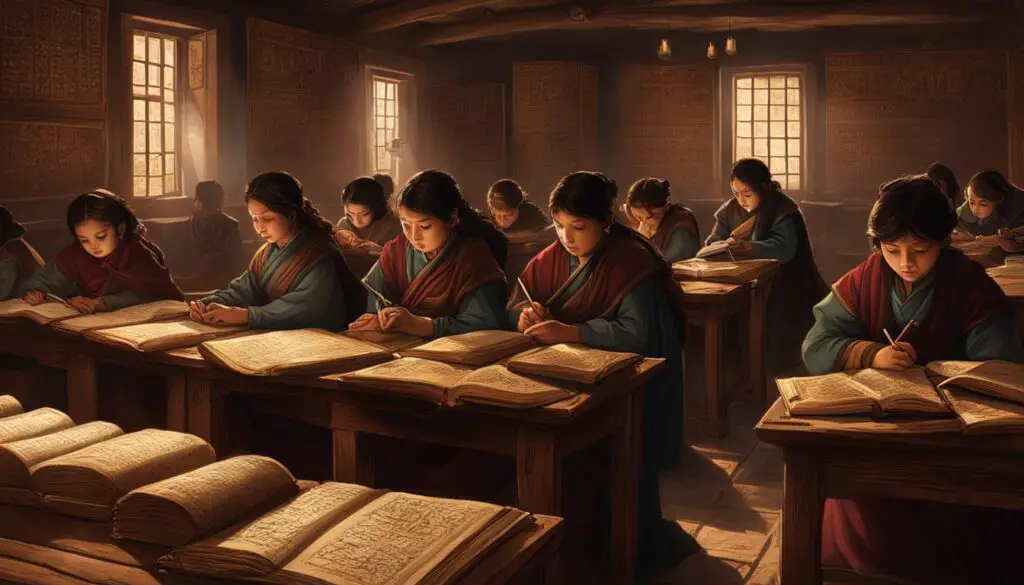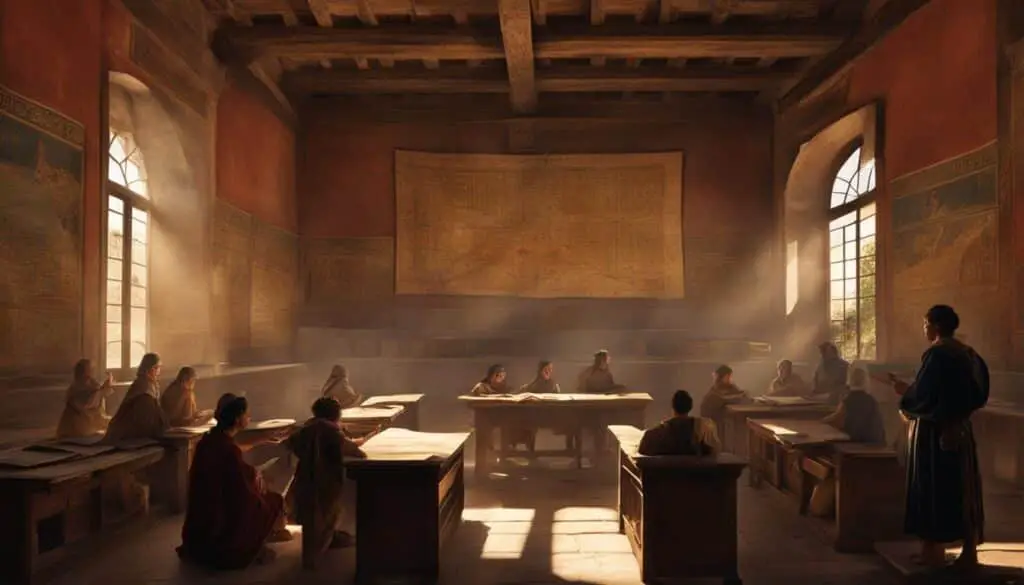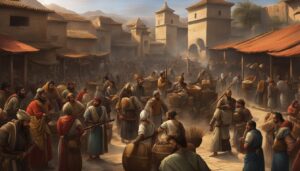
Education and literacy played a pivotal role in ancient civilizations, shaping their intellectual, cultural, and economic development. From Egypt to Mesopotamia and North China, these ancient societies emphasized the importance of written communication and formal education.
In Egypt, education was overseen by priests who taught subjects like science, medicine, mathematics, and geometry in formal schools. Two types of schools catered to privileged youth: one for future scribes and another for priest trainees. Education started at a young age and continued into late teens or early adulthood.
Mesopotamia had a similar educational system, focusing on training scribes and priests. The priests held significant power in the intellectual sphere and utilized methods such as memorization and copying models to impart knowledge. Meanwhile, education in North China had a secular and moral character, aiming to develop moral sensitivity and duty among students. Schools emphasized harmonious human relations, rituals, and music.
The transition of Jews between 70 CE and 1939 CE highlights the role of education in their economic success, further underscoring the importance of education in ancient civilizations.
Key Takeaways:
- Education and literacy were highly valued in ancient civilizations.
- Egyptian education was controlled by priests and taught various subjects.
- Mesopotamian education focused on training scribes and priests.
- Education in North China had a moral and secular character.
- Educational systems played a significant role in shaping the ancient societies.
Ancient Book Culture and Education Systems
In ancient civilizations, education and the transmission of knowledge relied heavily on written texts and books. The ancient Egyptians and Mesopotamians had formal schools dedicated to teaching reading and writing. The Egyptians had two types of schools for privileged youth – one for scribes and the other for priest trainees. Similarly, the Mesopotamians had numerous schools specifically for training scribes and priests, which were as numerous as the temples.
The priests in both Egypt and Mesopotamia dominated the intellectual and educational domains. They controlled the libraries and employed various methods such as memorization, oral repetition, copying models, and individual instruction to teach their students. These ancient civilizations also had a strong book culture. Books were considered valuable and were meticulously preserved in libraries and temples. The act of reading and writing was highly respected, as it was the key to acquiring knowledge and maintaining the history and traditions of the civilizations.
Ancient China also had a well-developed book culture and education system. The learning process in China focused not only on literacy but also on moral sensitivity and intellectual development. Formal colleges and schools were established in the imperial capitals, where students learned subjects such as history, religion, and the arts. The Chinese education system aimed to cultivate well-rounded individuals who could contribute to society and uphold moral values.
“Books are the quietest and most constant of friends; they are the most accessible and wisest of counsellors, and the most patient of teachers.” – Charles William Eliot
Ancient Education Systems: A Comparison
| Education System | Main Focus | Teaching Methods |
|---|---|---|
| Egypt | Training scribes and priests | Memorization, copying models, individual instruction |
| Mesopotamia | Training scribes and priests | Memorization, oral repetition, copying models |
| China | Literacy, moral sensitivity, intellectual development | Formal instruction, emphasis on rituals and music |
These ancient civilizations recognized the importance of education and the written word in preserving their cultures and imparting knowledge to future generations. The ancient book culture and education systems laid the foundation for the development of intellectual traditions and specialized occupations in later centuries. Through their dedication to literacy and education, these civilizations left a lasting legacy that continues to influence our understanding of the past.

Roman Education and the Role of Tutors
In Ancient Rome, education was structured differently compared to other ancient civilizations. Instead of formal schools, education was primarily provided by private tutors. Wealthy families employed tutors to teach their children at home, while less well-off children were taught in small groups. The role of tutors was crucial in shaping the education and upbringing of Roman children.
The teaching conditions for tutors varied greatly. Some tutors had the privilege of working in the comfort of wealthy families’ homes, where they had access to extensive resources and a conducive learning environment. However, other tutors had to make do with limited facilities, renting rooms or even teaching in outdoor public places.
Roman schools, on the other hand, were privately operated and dependent on tuition fees. Teachers, including tutors, held relatively low status in society, and the profession was seen as humble and paid poorly. Parents paid school fees in instalments, leading to frequent issues with non-payment.
The Roman educational system had three levels. The first level focused on basic literacy and numeracy, providing students with foundational skills. The second level involved advanced grammar and rhetoric, which aimed to develop students’ language and communication abilities. The highest level of education focused on public speaking, law, politics, and philosophy, equipping students with specialized knowledge and skills for future careers.
To keep students engaged, some Roman teachers employed incentives, while others resorted to physical punishment as a disciplinary method. The education provided by tutors and the Roman educational system as a whole laid the foundation for the specialized occupations of the urban population in later centuries.
A Comparison of Ancient Teaching Methods and Teaching Conditions
| Education System | Teaching Methods | Teaching Conditions |
|---|---|---|
| Egypt and Mesopotamia | Memorization, copying models, oral repetition | Controlled by priests, mainly taught in formal schools |
| North China | Emphasis on moral sensitivity, harmonious human relations, rituals, and music | Formal education starting at seven years old, schools focused on moral development |
| Rome | Private tutors, incentive-based teaching, physical punishment | Varied teaching conditions, ranging from wealthy homes to rented rooms or outdoor locations |
Through a comparison of ancient teaching methods and teaching conditions, it becomes evident that each civilization had its unique approach to education. While Egypt and Mesopotamia emphasized memorization and copying models, North China placed a strong emphasis on moral sensitivity. In Ancient Rome, education was primarily conducted through private tutors, whose teaching conditions varied depending on the wealth of the families they served.
Despite the differences, education in all these civilizations played a significant role in shaping the intellectual, cultural, and economic development of their societies. The emphasis on education and literacy in ancient scriptures helped pave the way for the academic traditions and specialized occupations that emerged in later centuries.

Conclusion
The study of education and literacy in ancient civilizations provides fascinating insights into the early academic traditions and ancient learning techniques that shaped these societies. From Egypt to Mesopotamia and North China, formal schools and written texts played a pivotal role in the transmission of knowledge and the development of educated individuals.
Ancient civilizations like Egypt, Mesopotamia, and North China valued literacy and education, focusing on training scribes, priests, and the nobility. These civilizations had well-established education systems that aimed to cultivate not only intellectual abilities but also moral sensitivity and vocational skills.
The ancient book culture, with its reliance on written texts, was instrumental in the learning process. Methods such as memorization, oral repetition, and individual instruction were employed to ensure the effective transmission of knowledge. These practices fostered a rich intellectual environment and aided in the preservation of cultural heritage.
In Ancient Rome, education took a different form, primarily provided by private tutors. Despite the variations in teaching conditions and social status, Roman education system had three levels of learning, building a strong foundation for specialized occupations and intellectual pursuits in later centuries.
Ancient scriptures bear witness to the significance of early academic traditions, ancient learning techniques, and the preservation of knowledge through written texts. These practices shaped the intellectual, cultural, and economic development of ancient civilizations and set the stage for the establishment of educational institutions and specialized occupations in the future.
FAQ
What role did education and literacy play in ancient civilizations?
Education and literacy played a crucial role in ancient civilizations such as Egypt, Mesopotamia, and North China. These civilizations placed a strong emphasis on written communication and formal education.
How was education structured in ancient Egypt?
In Egypt, education was mainly controlled by the priests who taught subjects like science, medicine, mathematics, and geometry in formal schools. They had two types of schools for privileged youth – one for scribes and the other for priest trainees.
What methods did the priests use to teach in ancient Egypt and Mesopotamia?
The priests in both Egypt and Mesopotamia used methods like memorization, oral repetition, copying models, and individual instruction to teach their students.
How did education in ancient China differ from that of Egypt and Mesopotamia?
Education in North China had a more secular and moral character. It aimed to develop a sense of moral sensitivity and duty. Schools emphasized harmonious human relations, rituals, and music.
What was the role of education in shaping the economic success of Jews between 70 CE and 1939 CE?
The occupational transition of Jews during this period highlights the importance of education in shaping their economic success. Education played a crucial role in enabling them to pursue specialized vocations and contribute to economic growth.
How was education provided in Ancient Rome?
Education in Ancient Rome was primarily provided by private tutors. Wealthy families employed tutors to teach their children at home, while less well-off children were taught in groups. Teachers were seen as having a humble profession and were paid poorly.
What subjects were taught in the Roman educational system?
The Roman educational system had three levels of learning – basic literacy and numeracy, advanced grammar and rhetoric, and higher studies with a focus on public speaking, law, politics, and philosophy.
What were some common teaching methods used in ancient civilizations?
Tutors and teachers in ancient civilizations used methods such as memorization, oral repetition, copying models, and individual instruction to teach their students.
How did ancient civilizations transmit knowledge?
The transmission of knowledge in ancient civilizations relied heavily on written texts and books. Ancient Egyptians, Mesopotamians, and Chinese all had formal education systems that focused on teaching reading and writing.
What were the goals of education in ancient civilizations?
Education in ancient civilizations aimed at various goals, including cultural preservation, vocational training, moral and character development, and control of cultural deviation.








